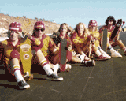As a techno-Luddite, I wondered about a few things.
Firstly, there was a rattle from one of the timing sensors.
Turns out that this was just a loose battery and was easily inserted back into the pincer holder in the unit.
Setup was easy, no soldering required. A cable goes from the 'start' sensor to a junction box; connection is via mini jack. Same goes for the 'finish' sensor.' A third cable goes into the stopwatch, then you line up the sensor beam reflectors and that's it.
On trying this out in the kitchen I found there to be an operational delay. This is so that once breaking the beam with the front leg, ther timer is not immediately reset with the back leg.
Here's how Rusty explained it:
Because he'd been so helpful, I thought I'd test him further and asked whether the system is waterproof and shock resistant. It all looked a little flimsy to me. Here's the reply:That reset function is actually a 3.5 second delay.
It prevents anything from breaking the beam less than three seconds after the first break.
It has several functions.
The most important of which is that lets say you are timing a skate boarder at knee height, and he goes through with his legs apart. Our system is easily capale of registering two distinct beam interruptions 2 or 3 milliseconds apart.
Since we had to build a circuit for that delay anyway, why not make it a few seconds long. that way if you are timing kids on horseback walking through the beam, or anything moving slowly it will also give you plenty of leeway.
It's not near as much fun to play with. But we thought you would appreciate no false starts on show day better.
It also acts as dust protection on dirt tracks.
say the car breaks the beam, and two or three seconds behind him is comes a huge coud of dust that can easily interfere with the infrared beam. Well, during that three second delay, the dust arrives, and if that dust were to break the beam again, the delay would reset again and continue to refuse to allow anything to trip the watch until the beam has been reestablished for at least three seconds.
So to fully understand it.
Break the beam, the watch starts, count to 2 and break it again, nothing happens. The red light comes on, but the watch does not stop. Now count to 4, and listen closely, you will hear the relay click. Now you can break the beam, and stop the watch.
Also remember, The watch does not care which is the starting line, and which is the finish.
Each time you break either beam you have electronically pushed the stopwatch button.
As long as the delay is going on, the button remains pushed. Go ahead, break the beam, and then try and use the button maunally, nothing will happen. (at least for the start/stop button not the lap button.
You can see just how long the delay is by resetting the watch to zero.
Then break the beam. Then start pushing the stop button over and over until the watch stops.
Just holding the button down will not have the same effect.
But what I wanted to increase the delay for some reason.
Break the beam, and then hold the stopwatch button down. now you can break the beam without it registering on the watch. But this only works if you pushed the button during the delay, and held it down the whole time.
Anyway, more than you ever wanted to know about the reset.
Glad it seems to be working.
Rusty
Tried it out in Hyde Park yesterday evening and it claimed that Mick Reiss is two hundredths faster than me.While it is not intended for underwater use, It will handle a rain storm without issue.
And even if it were submerged, if you allow it to dry before you turn it on again, it would probably be OK.
As for stray skateboarders, I think it will handle most things OK.
We like to say is guaranteed against anything but a slow moving trailer or a fast moving appaloosa.
Absolutely worst case is to break a solder joint.
The sensors themselves are designed for industrial use, you could run over it woth your car and not cause a problem.
I would be careful not to let the stopwatch get wet. especially around the hole for the plug.
Rusty
So it's not perfect.














